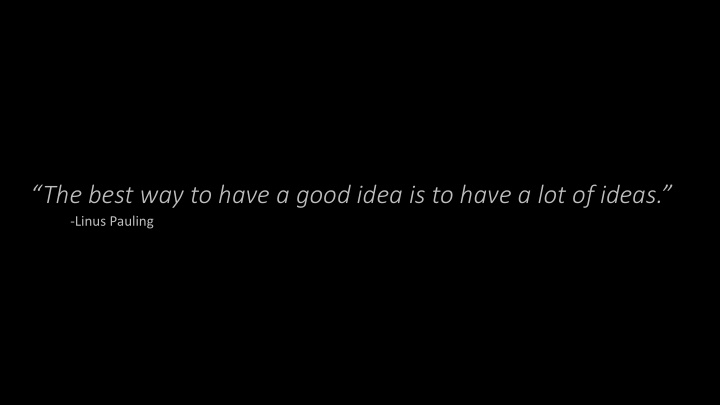



“The best way to have a good idea is to have a lot of ideas.” -Linus Pauling
Agenda • Wishful thinking • Break • Constraint removal • Lunch and excursion • Visualization awareness • Break • Storyboarding • Reflection
Guidelines • All ideas are valid – record them.
Wishful thinking Or, what would you like to be able to do?
Wishful thinking prompts • What would you like to know ? • What would you like to be able to do ? • What would you like to see ?
Data • cell For a cell, what class is it? • group of cells • cell class • section (slice) of cells For a cell class, search for cells that are connected to • connection it by a specific connection type. • connection type • entire database • something else… For a cell, what cell types can be reached by n hops?
Analyze your items • Which would have the greatest impact on your work? • What are the patterns or trends? • What are the outliers ? Why?
Constraint removal Or, what if you could do what you want?
1. Identify constraints For a cell, what class is it? Constraint: Electron microscopy and chemical analysis are mutually exclusive
2. Remove constraints what then? For a cell, what class is it? Constraint: electron microscopy and chemical analysis are mutually exclusive Constraint removal: suppose you could somehow do both. Then what? What would this allow?
Lunch and excursion Or, what can you relate to what we’ve talked about today?
Visualization awareness Or, what’s going on in the visualization zoo?
Activities • We will present seven visualizations from various fields • Informally discuss data and tasks • Relate aspects of these examples to what we’ve talked about • e.g., data, tasks, layout, interaction, colors, and aesthetics
LineUp LineUp: Visual Analysis of Multi-Attribute Rankings. S. Gratzl et al. 2013. IEEE Transactions on Visualization and Computer Graphics (Proc. InfoVis)
Data • Hundreds of items – e.g., universities • Tens of attributes per item – e.g., student-teacher ratio, citations, etc Tasks • Rank items based on weighted attributes • Interactively refine and explain ranks
ABySS-Explorer ABySS-Explorer: Visualizing Genome Sequence Assemblies. C. B. Nielsen et al. 2009. IEEE Trans. Visualization and Computer Graphics (Proc. InfoVis)
Data • Genome sequences divided into short, contiguous chunks - “contigs” • Automated assembly of chunks into larger genes – “assembly” Tasks • Understand assembly structure • Assess assembly quality
Data
Feeling the Crunch of the Deadline From VisualSedimentation.org
Data • 20 different project repositories • Series of commits 20 days before a paper deadline Tasks • Enjoy the visualization • Sympathize with the researchers
Multivariate Network Exploration and Presentation: From Detail to Overview via Selections and Aggregations Multivariate Network Exploration and Presentation: From Detail to Overview via Selections and Aggregations. S. Elzen and J. van Wijk. 2014. IEEE Trans. on Visualization and Computer Graphics. (Proc. InfoVis)
Data • Collected from the census • ~3000 nodes represent US counties • ~80,000 edges represent migrations between counties Tasks • Explore relationships between nodes and attributes • Present results of exploration
Exploring the data
One-hop migration
Two-hop migration
Les Misérables Co-occurrence From Mike Bostock’s Blog
Data • Characters in the play Les Misérables (tens) • Edges representing co-occurrences Tasks • Enjoy the visualization • Understand patterns in co-occurrences
NeuroLines NeuroLines: A Subway Map Metaphor for Visualizing Nanoscale Neuronal Connectivity. A. Al-Awami et al. 2014. IEEE Transactions on Visualization and Computer Graphics (Proc. InfoVis)
Data • Electron microscopy volume • Manual annotation of cells and synapses Tasks • Explore synapses patterns with respect to connections, branching, and pathways
Poemage Poemage: Visualizing the Sonic Topology of a Poem. N. McCurdy et al. 2015. IEEE Transactions on Visualization and Computer Graphics (Proc. InfoVis) [Under Review]
Data • Raw data: text • Derived data: rhyme sets – sets of words linked through sonic/linguistic resemblances Tasks • Explore individual rhyme sets in the space of the poem • Explore the sonic topology of a poem – the complex structures formed via the interaction of rhyme sets across the space of the poem.
Storyboarding Or, what does interaction with future software look like?
Sketching • This is not about pretty pictures • This is about ideas • Flesh out & communicate your ideas on paper
Image: http://i2.wp.com/www.alexemde.de/wp/wp-content/uploads/2014/07/Storyboard-1.jpeg
St Stor oryboarding • Focuses on the tasks • Show the person and the flow of events o e.g. a comic strip • Accomplish: setting , sequence , & satisfaction
Reflection and conclusion Or, what are the most interesting ideas from today?
Recommend
More recommend